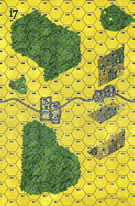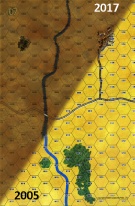|
Booted from Botosani Romanian Soil #1 |
||
|---|---|---|
| (Defender) Romania | vs | Soviet Union (Attacker) |
| Formations Involved | ||
|---|---|---|
| Romania |  |
8th Infantry Division |
| Soviet Union |  |
232nd Rifle Division |

|
| Overall Rating, 5 votes |
|---|
|
3.6
|
| Scenario Rank: 329 of 964 |
| Parent Game | Romanian Soil |
|---|---|
| Historicity | Historical |
| Date | 1944-04-07 |
| Start Time | 08:00 |
| Turn Count | 24 |
| Visibility | Day |
| Counters | 76 |
| Net Morale | 0 |
| Net Initiative | 2 |
| Maps | 3: 17, 2, 7 |
| Layout Dimensions | 84 x 43 cm 33 x 17 in |
| Play Bounty | 154 |
| AAR Bounty | 155 |
| Total Plays | 5 |
| Total AARs | 3 |
| Battle Types |
|---|
| Urban Assault |
| Conditions |
|---|
| Off-board Artillery |
| Scenario Requirements & Playability | |
|---|---|
| Eastern Front | Maps + Counters |
| Romanian Soil | Base Game |
| Road to Berlin | Maps + Counters |
| Introduction |
|---|
|
The town of Botosani controlled the road net (such as it was) east of the Seret River, so 40th Army designated it as a first-day objective for 2nd Ukrainian Front's upcoming offensive. In late March, Gen. Otto Wohler had started pulling Romanian formations from the front lines as soon as German ones became available, because he was convinced the Romanians "had no discernible desire to fight." But the Romanians were still at Botosani when the Red Army attacked. |
| Conclusion |
|---|
|
The Romanians put up what defense they could, and then withdrew southward with the enemy in hot pursuit. The 8th Infantry Division had just returned to the front after being decimated at Odessa in 1941, and would soon be destroyed again. |
| Additional Notes |
|---|
|
There were no Romanian wagons in the PG universe when this game was released. Players may either substitute German wagons or download the the DIY counters for Romanian transport from Avalanche Press. |
| 2 Errata Items | |
|---|---|

|
The reduced direct fire value in Kursk: Burning Tigers is 4-4. (plloyd1010
on 2015 Jul 31)
|

|
Kommissars never get morale or combat modifiers. Ignore misprints. (Shad
on 2010 Dec 15)
|
| Delaying action |
|---|
|
In this scenario a badly outmanned Romanian force must delay and deny a much larger Soviet force entry into Botosani (which, from Google Maps, looks exactly like the town on Board 2). My initial read of the scenario indicated that the Romanians were too weak to do much of anything and that the Soviets would just roll through them easily. Frankly, the terrain (a river to cross and two suburban towns to clear, in the midst of forested areas) seemed more daunting than the Romanians. Wrong again, The Romanians held on tightly to the suburban towns disrupting the Soviet advance and causing them to have to spread their superior force thinly and without bringing their numerical strength to bear on Botosani until late in the game. Indeed the suburbs held out until the 18th turn (4 1/2 hours) and were a main reason why the game ended in a draw and not a Soviet victory. Overall a lot of fun in a situation that seemed to be anything but. |
| 0 Comments |
| Una victoria trabajada | ||||||||||||
|---|---|---|---|---|---|---|---|---|---|---|---|---|
En este escenario se enfrenta un batallón de fusileros soviéticos a tres compañías de infantería rumana. Los soviéticos son los atacantes. Ambos bandos tienen una moral idéntica (7/6). Las condiciones de victoria son las habituales en los escenarios desarrollados por el Sr. McNair en los últimos años: se conceden puntos de victoria (VP) por causar bajas al enemigo y por ocupar hexes de ciudad, con la particularidad de que puntúan más dichos hexes de ciudad cuanto más al Oeste se encuentran (téngase en cuenta que los soviéticos entran por el Este). El plazo es suficientemente largo - 24 turnos- como para llevar a cabo sin precipitaciones una táctica bien meditada. Dado que, como he dicho, los VP se cotizan más cuanto más al Oeste están los objetivos, los rumanos despliegan una tenue pantalla en las posiciones adelantadas (pequeñas ciudades y carreteras) susceptibles de enlentecer el avance del enemigo, concentrando el grueso de sus fuerzas en la ciudad grande (Botosani) en el extremo occidental del campo de batalla. Los soviéticos, por su parte, deciden avanzar lo más rápido posible hacia Botosani con la mayoría de sus efectivos, sin obcecarse en la conquista de los núcleos de poblacion intermedios. Los soviéticos, por tanto, llevan a cabo metódicamente una táctica de neutralización de las posiciones intermedias enemigas, sin intención de aniquilarlas. Este objetivo lo consiguen asaltando las posiciones enemigas en hexes de ciudad y conservando un único pelotón de infantería en el hex asaltado, de manera que el enemigo se ve bloqueado en éste, incapaz de contraatacar con éxito y sin posibilidad de interferir el avance del resto de las fuerzas soviéticas. Al final, éstas llegan en masa a Botosani, se infiltran a través de su amplio perímetro y ocupan una buena parte de sus hexes. El resultado final no puede ser más elocuente: los soviéticos consiguen 65 VP frente a 8 VP de los rumanos. Una victoria rotunda. Tengo anotado que jugué este mismo escenario hace año y medio y que el resultado fue completamente diferente: una victoria mayor rumana. No recuerdo los detalles, pero me imagino que entonces los soviéticos se obcecarían en una lenta conquista de las posiciones intermedias en lugar de concentrase en el único objetivo que realmente valía la pena: Botosani. Una magnífica lección de táctica. |
||||||||||||
| 0 Comments |
| Watch those flanks | ||||||||||||
|---|---|---|---|---|---|---|---|---|---|---|---|---|
Soviets move north to south against the short axis of three boards. The northern-most (#7) is mostly clear, but has a minor river. This river is not much of a factor given that the Soviet force is entirely on foot. This board holds a four-hex town worth 1 VP per hex. The center board is where the bottleneck terrain (#17); it holds a four-hex town and a two-hex town worth 2 VPs per hex. Board 2 is the southernmost, holding a twenty-one hex city worth 3/4 VPs for Rom/Sov. Given that all of the town hexes on boards 7 & 17 were worth a total of only 16 VPs compared to the huge # of VPs for the city (Botosani), I considered simply loading all of the ROM forces there and just let the Russians come to try to assault the city. As this seems droll, I attempted the following defense for the ROM side: 1xINF on the west board edge in a woods hex supported farther south by a 47mm gun in another woods hex; 1xINF+1xHMG in the town on board 7; 2xINF dug-in on the bridge; 2xINF+1HMG dug-in at the cross-roads (not in same hex) on board 7; 1 HMG dug-in two hexes north of the four-hex town on board #17; 2xINF + ENG in that town. So what I envisioned here was a series of "road blocks" holding the main N-S road with small holding forces for the east and west board edges (as these allow for avoidance of two large woods that lie E&W of the main N/S road on board #17. Soviets: Eastern battle group: Cpt+2LTs+6xRIF+4xSMG (aimed for the four-hex town on board 7). Western battle group: Cpt+2LTs+6xRIF+1SMG. Center battle group: LtCol+2Cpt+2LT+KOM+7xRIF+6xHMG+mortars/guns. As the Soviets drew a 10-2-1 captain, it was envisioned to have a row of all six HMGs acting as a DF suppressor force. By Turn Five: Eastern battle group: Soviets hold three town hexes; assault with 3xSMG+ldr vs. lone ROM HMG. This assault was not ended until turn #12 due to a run of wiffs and/or made moral checks/recoveries. At one point, two of the Soviet SMGs were demoralized. The remainder of the Soviet eastern group got caught by a '12' roll by the ROM 47mm gun on OF as they attempted to move past (lost a few turns on morale recoveries from that debacle). Western battle group: also not well for Soviets; combination of OBA and the single ROM INF demoralized an entire hex (LT+2RIFs). Center battle group: bridge hex assault cleared by turn four. Soviets begin working around the road block; ROM pull back to join with the block farther south.E Turn 12: Eastern battle group: the assault vs. the ROM HMG continues. The ROM 47mm was toasted by OBA and Soviets have now turned this flank. A Cpt+LT+4RIF followed by stragglers from morale failures (that gun did not go away quietly) now moving to approach Botosani from the NE. Western battle group: highly fragmented at this point, however, the LT and short range of ROM INF allows Soviet units to move forward as they are not threatened even without a leader. There was a two-RIF unit (ldr-less) about to enter board #2 from the NW; a leader with 1RIF+1SMG about five hexes back; and a leader with 1.5RIF steps another five hexes back. So ROM resistance here caused damage & fragmentation of the Soviet battle group, but this flank was now turned and free of ROM units. Center: After several turns of chaotic battle; the ROM still held the four-hex town on board 17 with 1 ENG+1INF+1HMG (and two DEM half-steps) facing 5 good-order, full-strength RIF + 5 GOFS HMGs + a few stragglers. Step losses at this point: ROM lost 11; SOV lost 6. I halted the game here. The ROM had three INF steps + 60mm gun in Botosani (from earlier tactical withdrawals), but the Soviets had units moving in from E & W at the board 17/2 edge effectively cutting off the units holding the towns on board 17. Even were the ROM able to extract himself without damage from board 17, the Soviets simply had too many units remaining. That is, even if the ROM had a board 2 city hex with all of his units remaining (essentially seven), the ROM player would have scored 7*3 = 21 VPs for city hexes. The Soviet, controlling the remainder, would hold fifteen town hexes on board 2 for 60 VPs + the other town hexes. The twelve turns remaining was sufficient time for all the SOV flanking units to reach Botosani. Miscues: The idea of the massive HMG group being joined by the 10-2-1 captain didn't really pan out; morale checks and such kept this group somewhat splintered. The idea of an orderly ROM withdrawal back to Botosani on board 2 didn't work; morale failures and recoveries (especially disruptions) prevented efficient disengagement. I overestimated the ROM ability to carry out a withdrawal (or, perhaps, held out too well in the center at the expense of those flanks). Perhaps the ROM should have devoted more units to pinching off East & West board edge and simply not bothered with the town on board 7 (worth only four points anyway), albeit on HMG did tie up 3xSMGs + 1LT for about six turns. Also to be noted is that leaderless groups can still "advance" when there is little DF sweep. This allowed the Soviet units to continue forward and eventually regroup, rather than having to send leaders backwards My overall "impression" of this was not unlike perhaps the German defense of Normandy. Things looked good for the ROM for about ten turns, but when finally the lines were breached (especially those flanks), the defense fell apart. |
||||||||||||
| 0 Comments |

 RoRB010
RoRB010 
























